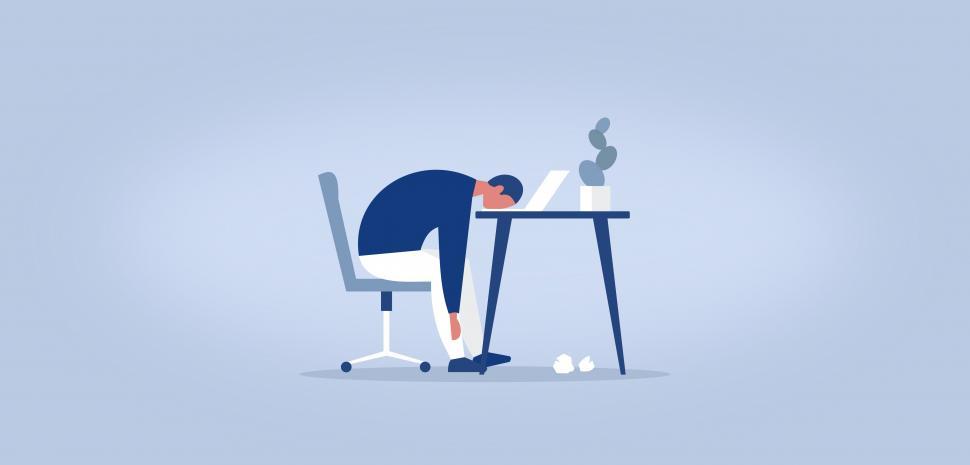Summary:-
As we head into the second wave of Covid-19, you and your team may be feeling foggy, cranky, and fatigued. The adrenaline of the first wave is over and, while good news about a vaccine is on the horizon, getting through the winter may be the toughest leadership challenge of all. What should you do when assurances that “we’re all in it together” are met with scepticism and annoyance, and when you’d rather snuggle up in bed instead of strategizing for the future? Leaders should focus on three areas: understanding the difference between urgency and importance, and focus on the latter; be compassionate while also driving your employees to action by channelling their feelings of defiance, anger, and frustration. Finally, change things up every single day with a focus on energizing your team.

“What happened to my resolve?” a leader remarked in the middle of a session.
We were discussing how he and his team were navigating the second wave of the pandemic and responding to the breaking news that a vaccine might be on the horizon. On the surface, everything was fine: The business was thriving and his company was in a good position.
Still, that remark captured his true concern: On a personal level he was experiencing a loss of agency, determination, and energy. The “steady hand” approach and rapid action mindset that had characterized his leadership during the first wave were becoming fuzzy, less ingenious, and much more volatile.
As we dug through the layers of the organization, it turned out that the feeling was widespread among other leaders and managers. Stress incidents were on the rise, people’s emotional reactions were becoming more polarized, and there were more team defections.
The same is likely true across a broad range of companies and sectors. It goes by different names: “pandemic fatigue,” “mental fog,” “work/life blur,” “extended vacuum,” and an “endless wait,” just to mention a few phrases I have heard leaders use. Clients mention that they are fed up and bored and that “2020 has been beyond heavy.” Even those working in booming industries report that they feel “emotionally amputated.” “The other day I cried for no reason,” another (usually hard-nosed) client told me. Others struggle with not being able to do things like exercise with great enthusiasm, as they did during the first wave of the pandemic. Their brand-new collection of home fitness gear is gathering dust. And no one gets a kick from yet another virtual “happy hour” at work.
It feels like the whole world is tired. Even though the vaccine shines a light at the end of the tunnel, the home stretch will be long and perhaps take a greater toll on our professional and personal lives than we expect it to.
Resilience is the most fundamental quality for navigating through chaos. The belief that we have the ability and the strength to overcome obstacles and perform involves a constant balancing act, and for most it is a lifelong challenge. Without resilience we tend to act indecisively or follow directions blindly. If we are not confident that we have the necessary abilities, we risk getting paralyzed or subjected to forces beyond our control. Managing your own mind and deciding to take charge of your destiny (and helping others do the same) is where you find mental strength for the last mile.
To move through the second wave successfully, leaders need to reexamine their personal resilience and that of their team members: the ability and strength to overcome obstacles, bounce back, and recover in the face of challenges. How strong are you under pressure? How quickly do you bounce back from defeat?
Most importantly: How can you find the mental strength to lead through the last mile?
How to Lead When the Whole World Is Tired:
Compared to the adrenaline-fueled response in the spring and the false dawn about the recovery over the summer, the second wave requires a new understanding of personal resilience. In the first wave, personal resilience relied on a psychological emergency response called arousal. Shocks, threats, and sudden uncertainty make us super alert and we activate resources that are skin-deep: Adrenaline, fighting spirit, and pulling together. This response is impulsive, almost universal, and immediately recognizable across many teams.
Personal resilience in the second wave is a different story because it relies on psychological stamina. Psychological stamina rests on more deep-seated emotional patterns shaped by our individual needs, histories, and experiences. Stamina is required because, frankly, the second wave is not exciting at all. People report feeling bored, disconnected, and unnerved. In contrast to the skin-deep reactions of the first wave, the second wave requires perseverance, endurance, and even defiance against the randomness, gloom, and burden of the pandemic.
Cultivating resilience requires some emotional rewiring and calls for a different kind of appeal to team members and colleagues. The essential task is to identify your biggest challenges over the next year and then tap the psychological stamina you and your team needs to get there. There are three key steps: understanding the difference between urgency and importance; balancing comfort with containment, and finding new ways to energize yourself and others.
Understanding Urgency vs. Importance:
This may sound self-evident, but it is amazing how much entire organizations avoid facing up to the toughest challenges ahead. One reason is our natural response to crises: We become short-sighted and push aside all that is not urgent. Once we have fixed what is urgent, we feel we deserve a good rest. In several of the top teams I currently advise, there is a tendency to either fail to see the coming challenges or to rationalize, “When Covid-19 is over, we will address the problem.”
Leaders and teams must avoid this temptation. While rest is vital outside the workday, inactivity during it can backfire. In military units, for example, boredom and waiting time are perceived as more stressful than actual combat. In the study “The Challenges of the Disengaged Mind,” researchers found that when people were ordered to sit in a room and do nothing, they chose to give themselves electric shocks rather than pass the time in silence. Most people seem to prefer to do something rather than nothing, even if that something is unproductive or harmful. As a high-ranking officer in NATO told me for my book Battle Mind: “It is better to act and make a decision than not to act. In other words, the consequences are often greater if you decide not to act than if you do act. A willingness to take risks is a precondition for being able to act under pressure or in demanding situations.”
The way ahead may be to follow the example of a CEO I advise. Even though her business has been successful throughout Covid-19, she chose not to rest on her laurels but to ask: “How do we turn the short-term momentum into long-term advantages?” She asked her executive team to come up with ideas for the future and set up a task force with high-performing talents from across the organization. Specifically, she asked them to consider the steps they could take here and now, steps that would in the years to come eventually become longer-term competitive advantages.
Another approach would be to ask yourself and your colleagues whether you are in fact fully prepared for the feeding frenzy that will inevitably kick off in the wake of the vaccine. Companies will clamor to win back lost business and reclaim lost customers. For many businesses, dealing with the aftermath will be just as intense as dealing with the crisis.
Ask yourself and your teams: Are you doing all you can do to emerge from the crisis as a stronger company? The window for change may be closing and the time to turn good intentions into action is now.
Balancing Compassion and Containment:
In order to act, you and your employees must be motivated to act. Specifically, action requires both compassion and containment.
First, let’s look at compassion. At this point in the crisis, the conditions that breed depression, loneliness, and anxiety are present: Working in isolation, health concerns, job insecurity, heavy workloads, and rapidly shifting priorities. A global survey conducted by Mercer found that the majority of the 270 insurance companies surveyed now rate mental health as being as much of a risk as smoking.
Leaders need to be serious about mental wellbeing and intervene sooner rather than later. This means that your employees need more warmth and comfort than they might have prior to the pandemic. But you can’t soothe your team with spreadsheets and plans; that takes listening and daring to stay in the hardest moments –daring to talk about doubt and discomfort — instead of skipping ahead to the next item on the agenda.
There are a couple of ways to approach this. One involves saying “I don’t know” or sharing your own feelings of discomfort. I see an enormous difference in leaders who express their insecurities, because it goes both ways: When you dare to tell your team about the issues you struggle with, they will follow suit.
Another approach involves encouraging the fundamental feeling that people are good enough, that they have earned their place, and that their worth is not just a function of their actions and results, but of who they are and how they carry themselves. So, don’t only talk about “getting things done” in your conversations with your colleagues, but also recognize “who they are” using specific examples of their personal contributions and human qualities. This will reduce anxiety and second-guessing.
Compassion, though, must be balanced with containment. Containment is described by IMD professor Anand Narasimhan as “the ability to observe and absorb what is going on around you, but to provide a sense of stability.” Stability comes from setting limits, raising the bar, keeping the pressure at the optimal level, and helping each other snap out of self-pity and moodiness.
In fact, too much caring and compassion can drive people into a learned helplessness trap, believing that they can’t perform without help and support from others. As the father of modern positive psychology professor Martin Seligman demonstrated, we experience learned helplessness when we face uncontrollable and inescapable stress. We simply stop trying to respond to dangers and passively accept whatever harm befalls us.
So, once you lift people (or yourself) up, the goal is not pampering. Rather, it’s about using your connection to catch a second wind. And as any boxer will tell you, a second wind is brought on by defiance, anger, fear, and frustration. Feelings that we usually suppress or intellectualize in our professional lives.
So instead of lowering the temperature completely and feeling the effect of exhaustion and boredom, it might be a good idea to turn up the heat and go into fight mode. Take a good look at the battles that will meet you next year. How can you stay ahead of the curve? How can you prepare for the next stages? How can you mobilize and be able to attack before dawn?
In my conversations with a wide range of leaders, they repeatedly emphasize how important it is to be able to do something instead of letting go. Perhaps you feel like staying in bed all day watching Netflix and eating pizza, or “snug under the duvet,” as one of my clients describes this type of reaction. Once in a while this may even work well with a bit of constructive denial and self-indulgence, but not every day and not every time things get hard.
Yes, the current moment calls for compassion, but it also calls for a little more edge and collective defiance against the injustice of the virus. You want people to say “enough is enough” and rise to fight against the gloom. As with good parenting, the key is to find the right balance between caring and challenging, between compassion and containment, between saying “you are good enough as you are” and “get moving and get to the next level.”
Energize Everyone, Every Day:
“I’m surprised that the hardest part right now is managing my own mind,” the CEO of a large-cap company concluded with a sigh near the end of our session.
As we enter the last stretch, the greatest challenge for leaders may be to sustain energy in themselves and in their teams. We don’t quite know how long it will take to finish the last mile and we cannot rely on the urgency of the crisis any longer. Patience with feel-good language like “we need to pull together” or “we will get through this” is now close to zero. The appetite is for specific and actionable communication — what to do now to pull together and how to get through it.
The key is to get the energy flowing and never accept that meetings and interactions become stale or boring. Energy is not a given and must be generated and channeled internally. For example the LEGO Group has defined the goal to “Energize Everyone, Every Day” as a central leadership principle.
There are many ways to energize: Sharing success stories, setting up competitions, dividing long projects into sprints, communicating. But also shortening endless zoom meetings, cutting tumbleweed projects, and allowing constructive conflicts and honest feedback in your teams. How you do it matters less. That you do it matters immensely.
Further, people with a high degree of resilience tend to prevail because they interpret setbacks as temporary, local, and changeable. When something is viewed in this way, it leaves us able to think: “It will go away sometime, it can be curbed, and I can do something about it.” This enables us to act. It is the mindset of the resilient leader. Resilient people are more willing to make decisions because they believe they have a real impact on their situation and are not afraid to influence it.
Alternatively, if we face an obstacle thinking, “It is permanent, it is a general problem, and there is nothing I can do about it,” it leaves us with little or no power to act. People lacking resilience also tend to internalize the problem by ruminating and having thoughts like, “It is probably me. I am no good. I can’t do anything right.” This leaves the person paralyzed. You can probably imagine how these thoughts can spin out of control and end up in pure self-destruction.
—Source: Harvard Business Review







More Stories
Pomodoro Technique: A unique way to increase productivity
The Power Of Being An Introvert: Benefits Explained
How to Job Hunt When You’re Already Exhausted